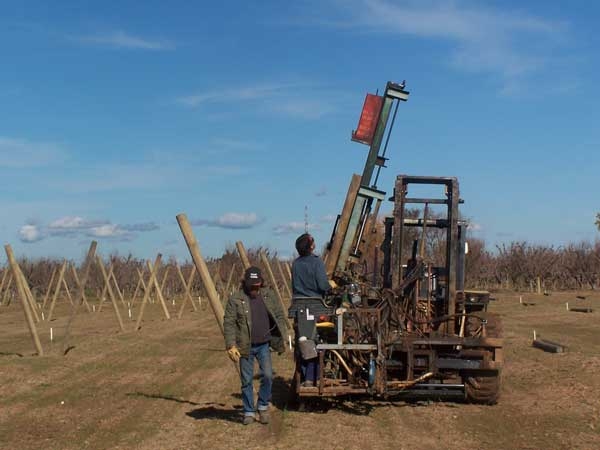Promotion: The virtues of the Tatura Trellis were widely publicised through field days, workshops, Agnotes, research reports and numerous articles in local, national and overseas papers, and in agricultural and horticultural magazines.
Promotion
A series of scientific papers were published, and a Ph.D. thesis on, Calculation of potential photosynthesis in closed canopies in orchards of trellis type was completed.
Visitors from every state in Australia and from all over the world came to the Tatura Research Institute to find out what this new research was all about.
Introduction to the world—the 20th International Horticultural Congress
In 1978, only five years after it had all started, a unique opportunity arose for the Tatura Trellis to be introduced to the horticultural world at the 20th International Horticultural Congress in Sydney.
Several Tatura researchers gave a cohesive account that centred on the concept and early results of the Tatura Trellis.
In December 1978, David Chalmers, Bas van den Ende and Leo van Heek were presented with the Productivity Improvement Award by the Productivity Promotion Council of Australia for a suggestion which led to higher productivity.
The following year Leigh Issell won the Productivity Improvement Award, ‘Best employee suggestion leading to higher productivity’ for his tree work on propagation.
In 1979, the American Society for Horticultural Science presented the Stark Award to David Chalmers, Bas van den Ende and Leo van Heek, authors of the paper, Productivity and mechanisation of the Tatura Trellis orchard in HortScience, for research on improving the quality, performance and longevity of fruit trees.
Commercialisation
After 1979, the Tatura Trellis was quickly commercialised.
We kept close contact with as many commercial Tatura Trellis orchards as possible in Australia and overseas.
Other research establishments in Australia and overseas have evaluated the Tatura Trellis, and have sometimes modified it to suit certain conditions, or have given it another name.
Mechanisation
Mechanisation of the Tatura Trellis was not cost-effective and often failed mechanically.
Although the Trel-Pik harvester from West Australia won an award at the Orange Field Day in 1982 for best invention, it was never commercialised and, along with its prototype, was sold for scrap metal and parts.
Orchardists have since built numerous platforms and harvesting aids. Unfortunately, most of these have been put away to rust.
This was a lesson that led to further research to make the Tatura Trellis more efficient and more cost-effective.
A reliable motorised platform, specifically designed for Tatura Trellis trees and manufactured by E.D. Parson, is now used in several orchards in the Goulburn Valley.
Mini-Tatura
The mini-Tatura was developed so that the entire orchard could be managed from the ground.
Few orchardists liked the narrow 3.5-metre rows of the mini-Tatura and believed that fruit trees on vigorous rootstocks could not be kept at a height of less than two metres, without growth-regulators and/or judicious and costly summer pruning.
Open Tatura
In 1989 a compromise was struck, when the Open Tatura was developed.
The Open Tatura consisted of 2000 to 3000 trees per hectare—densities that orchardists could afford.
The orchardist had good access to the trees, and sunlight penetrated throughout the canopy to produce high and early yield combining affordable densities with good accessibility, good penetration of sunlight throughout the canopy, and early and high yields.
Further R&D work refined the Tatura-type orchard, including the concept of the Instant Tatura Orchard, and Open Tatura moved temporarily to the USA.
In 1995 the refined Open Tatura was introduced in the Goulburn Valley and was immediately successful and widely adopted.
The Open Tatura has continued to evolve into a blueprint with several options that combine all the features of an efficient Tatura orchard system and is dubbed ‘The Orchard of the 21st Century’.
Further innovations continue to improve the Open Tatura system for fruit. Some of these innovations are made by, or in cooperation with, orchardists in Australia and overseas.
Minimises wind damage
A 1984 study on wind damage to kiwifruit by three scientists from the New Zealand Ministry of Agriculture and Fisheries showed that, with traditional shelter and trellis systems (T-bar and pergola), around 25 per cent of fruit was wind-damaged.
The fruit rubbed against each other and against canes of the vines. In comparison, a property using a Tatura Trellis system with minimal internal shelter lost only 1 per cent of its fruit from wind damage.
The success of the Tatura Trellis was related to the skimming flow because of the high density of roughness elements.
It has also been reported in the USA that V-systems are useful where strong winds are a problem.
Continued next month
See this article and photos in Tree Fruit January 2014






















